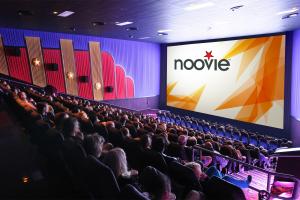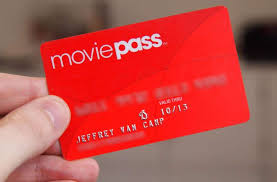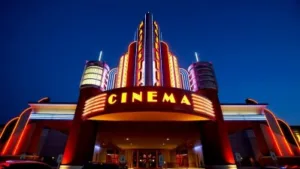The cinema has historically been the premium movie-viewing experience. But technical and business advancements are now challenging the very existence of movie theater chains. They are not likely to disappear, but big changes are likely to be needed for them to survive. Ten years from now, mainstream theaters will probably be quite different than they are today. Let’s take a look at the winds that are buffeting the industry.

On the technology side, HDR and 4K is becoming a mainstream display option in consumer’s homes. Both of these are rare in a theatrical environment. Image quality needs to be at least as good if not better in a theater than at home, so this is one big challenge.
HDR projection technology is, sort of, here today with Dolby Vision, IMax and éclair offering what may better be described as enhanced dynamic range. Maybe projection solutions can offer a wider dynamic range option in the future, but LED-based screens can do it now. These screens are very attractive, but no standards exist for content mastering, distribution, display or metrology for this technology, which is a head wind for adoption. But the biggest challenge is cost of the LEDs themselves. However, ultra fine pitch and microLED solutions are in development that could allow mainstream solutions to be cost competitive in two to three years.
In-theater audio solutions are often better than home solutions with immersive sound now popular and offering a much louder (if that is a benefit) environment. In addition, motion actuators and chairs are rapidly being adopted by exhibitors to create a theme-park-like ride experience coordinated with the movie. That’s something you definitely can’t get at home.
In the meantime, exhibitors have been focused on improving the theater ambience. This means upgrading seats so they are wider, offer reclining capabilities and big cup holders – just like at home. They are also improving their food and beverage options going way beyond candy and popcorn. Not only is this more enticing for theater goers, but it can be a good profit stream for exhibitors – especially ones that sell alcohol too.
Pre-show Entertainment
Another trend that is being developed is adding pre-show entertainment. Lobbies are being transformed to include digital signage for revenue generation, but to also show trailers to encourage more ticket sales in the future. Virtual reality pods are being installed so you can have some fun with your friends before the main feature – and spend more money.
National CineMedia is planning to now roll out an in-theater games they call “Noovies” which run before the trailers. Cinevaders is one recently shown to the media where the audience presumably uses their phone and an app to fight off invaders in the theater. The chain plans to roll this out to its 1700 theaters in the spring as part of its ARcade platform.


Alternatives to Movies
Alternative entertainment, i.e. non-movie content, has also been talked about for years as an opportunity and is getting some attention from exhibitors. For example, Fathom Events is a joint venture between AMC Entertainment, CineMark and Regal Entertainment that focuses on bringing rock concerts, opera, sporting events, fine arts and other quality entertainment to a theatrical venue. Tickets can cost up to $40 and the amenities can be better than the real venue in some cases.
eSports is another huge phenomenon that exhibitors should think about capitalizing on, although there does not seem to be much activity in this area in the U.S. right now. Booking corporate or civic events is also a really smart thing to do as movie theaters are mostly empty during the weekdays, so why not try to use that asset more efficiently.
As you can see, many of these new initiatives are aimed at offering a better and more diversified experience that also taps into new revenue streams. But is it working? Attendance in U.S. theaters has been flat for years, so maybe this is just staving off rapid declines. Raising ticket prices can be dangerous too.
Other Factors
So what other winds are blowing against theaters? For one, there is the all-you-eat content subscription model like Netflix, Amazon and many others. The main exhibitor chains have been loath to adopt such a model, but MoviePass has not (MoviePass Sees Boom with Price Cut). For a low monthly fee of around $10, you can attend as many as 30 movies a month in participating movie theater chains. The exhibitors are paid full price for each admission, so they are happy with that, but now MoviePass is gathering all of this customer-centric data, not the exhibitors. This is expected to be the whole reason behind this business model – that this data can be used to create advertising for MoviePass.

This model has not been proven yet as MoviePass continues to spend way more than it is taking in. But, it is also having an outsized impact on the industry. The company claims it is now buying 5.7% of all tickets sold per week with its 2M subscribers. That is expected to swell to 5M by the end of the year, which makes its subscribers start to look interesting for advertisers. The company says they are also driving a lot more people to see Oscar-nominated movies.
Ticket Buying is Changing
The ticket-buying experience is even undergoing change. Fandango allows consumers to buy theater tickets on-line which are refundable and can be purchased using Amazon Alexa voice commands. Fandango says these features are not only making it better and easier to buy tickets, it is actually driving more sales. Consider this: fully one-third of the opening weekend tickets to the hit movie, Black Panther, were sold thru Fandango to the 40K theaters participating in the service.
And Fandango has a competitor: Atom Tickets which is owned Fox, Disney and Lionsgate. Both now offer tickets via Apple iMessage and Facebook Messenger – a clear benefit for younger audiences and for group purchases.

Exhibitors also continue to argue for maintaining the theatrical window – which drives consumers to the theaters for must-see content. Maybe exhibitors should also take another page for the OTT crowd – consider offering episodic content as another inducement to attend.
In-house digital projectors are now starting to near end-of-life and the virtual print fee deals that funded their purchase are ending as well. How will exhibitors fund all this new technology and initiatives? That’s a good question. Exhibitor stock prices are down and foreign competitors are exploring snapping up chains (China’s Wanda bought AMC a couple of years ago).
As we have seen, there are lots of challenges facing the cinema industry, but there are lots of new ideas being explored as well in an effort to reshape the industry. How this will all playout remains unclear, however. Change is coming, so exhibitors need to embrace it and find ways to fund it, or be swallowed up by other forces. – CC

